Sealing The Pond
June 2005
Spoiler: We tried two applications of Sodium Bentonite clay (100 tons total) to seal our pond and it did NOT work.
Items on this page:
 Update #1 - June 8, 2005 - Work Begins
Update #1 - June 8, 2005 - Work Begins Update #2 - June 18, 2005 - Almost Done
Update #2 - June 18, 2005 - Almost Done Update #3 - June 23, 2005 - Done!
Update #3 - June 23, 2005 - Done! Update #4 - February 5, 2006 - A Little Water
Update #4 - February 5, 2006 - A Little Water Update #5 - Jaunary 18, 2007 - Eight Feet, 1 inch
Update #5 - Jaunary 18, 2007 - Eight Feet, 1 inch Update #6 - April 29, 2007 - Five Feet, 1 inch
Update #6 - April 29, 2007 - Five Feet, 1 inch Update #7 - June 6, 2007 - 7 feet
Update #7 - June 6, 2007 - 7 feet Background On Brushyland's Pond
Background On Brushyland's Pond

Update #1 - June 8, 2005 - Work Begins
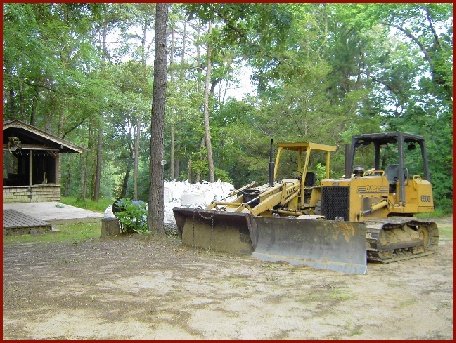
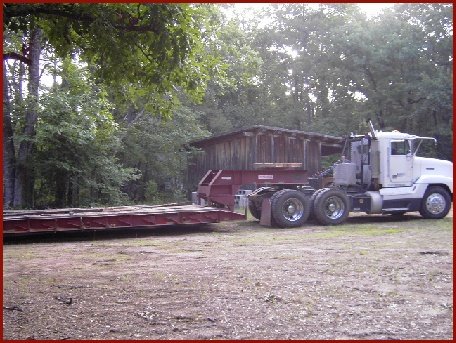
This is the large flatbed trailer used to transport the dozer and backhoe. Other flatbeds were used to transport the 72 tons of Sodium Bentonite clay.



Dad inspecting the progress after just two days of work. If the pond gets a good seal, the water should be head-deep where dad is standing.
- Potentially bad news. After a couple days of work, Harmon discovered that there is a high
water table under the entire pond site. He thinks that our main little "scoop" that always
holds water could have broken through to the water table - which would explain why it always has
some water in it, even in a drought. If this is the case, then when rain partially fills the pond,
the water pressure could force the water into the water table and away from our lake. Not
good. But, as you'll see in the below Update #2 Harmon will come to believe that the main scoop
has enough clay in the bottom to seal it from the high water table. But to be safe Harmon still
wants to put more of our natural clay and more of his Sodium Bentonite clay (a total of 72 tons
of Bentonite instead of 48 tons) in the entire pond site to protect it from the high water table.
Thus, this project went from a one week, $15,000 effort to a two week, $24,000 project. Ouch.
But believe it or not, that's still over ten grand less than what another pond sealing company
wanted to charge us. And they weren't even going to use dozers or extra clay from our land - they
were just going to spread the Bentonite and hope for the best.
- Harmon is going to pump the existing water out of the pond so that he can work most (if not all) of that area with his dozer. This will, of course, kill all the fish in the pond. I felt sorry for the fish, so I caught a few bass using a spinnerbait and transported them to nearby Lake Palestine in a trash can of pond water. LOL. I tried using stink-bait to catch some catfish but I couldn't get them to bite.

Update #2 - June 18, 2005 - Almost Done
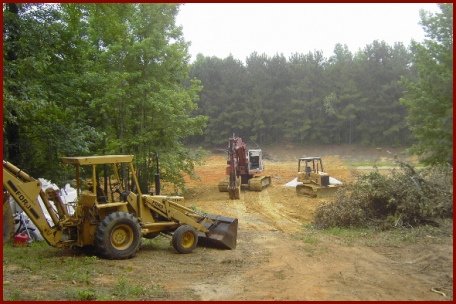

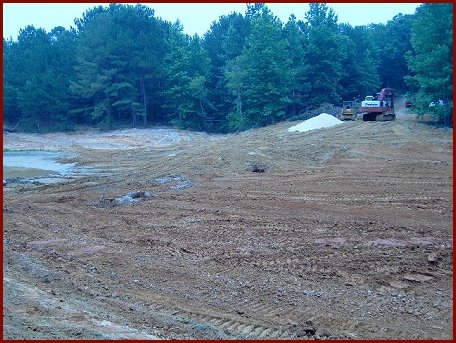
View from the dam. The area in the foreground is what we call our "second scoop" and is where we would ride our dirtbikes on a makeshift track.

- Potentially good news. Harmon still thinks that we have a high water table under the pond area
but he no longer thinks that the "scoop" that has always held water has broken through to the water
table. If that scoop had indeed broken down to the water table then anytime rain partially fills the
lake, the water pressure would cause the pond water to go into the water table and away from the pond.
Fixing that problem would have been very tough. But Harmon got a sample from the bottom of that
scoop (which still had a foot of water on it) via his trackhoe and discovered that it was good
clay - and that the clay was dry just a few inches from the top. So Harmon thinks this scoop
has alway held water simply because it has a very good clay liner.
- Potentially more good news. Harmon often uses his trackhoe to dig test holes in many places
when a pond is known to not hold water. While doing this, he discovered some "river gravel"
near our main scoop of water. That gravel is from the old creek bed that ran through the pond site
before the previous owners built the dam. That type of gravel is notorious for carrying away
water. He feels very sure that this is the main reason why our pond wouldn't hold water. He has
already packed over a foot of clay on top of the gravel and will put lots of Sodium Bentonite on top
of that. Harmon sounds very confident that this pond will now hold water. We shall see.
- Fair news. After digging a few test holes, Harmon noticed that some of the areas where we have sand (like on the slope leading towards The Compound) actually has clay under it. That's good news. But he thinks that the southern feeder channel leading into the lake (i.e. the cut that we normally pump water from to work the potty) contains very leaky sand with no clay under the sand. So he thinks the pond will leak in that area. That cut always seems to have some water in it, so it might actually be able to hold water. But Harmon built a small clay damn on the pond side of that channel so that our pond won't completely drain if that channel can't hold water.

Update #3 - June 23, 2005 - Done!!
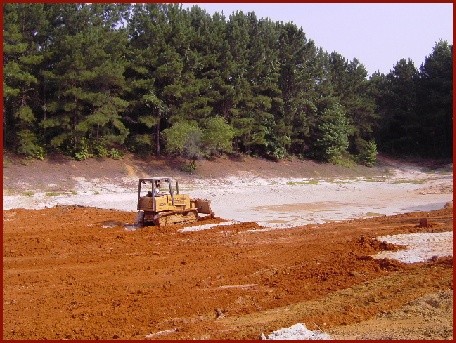

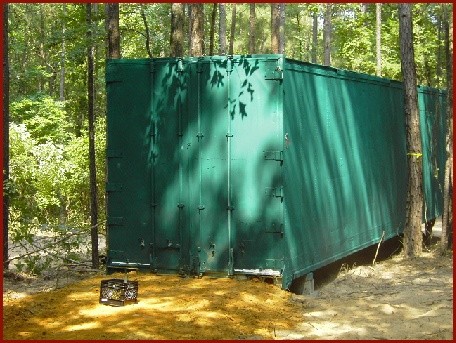
Dad paid Harmon to haul in a 48 foot long 18-wheeler cargo container, paint it green and place it in the woods where it will be fairly hidden.
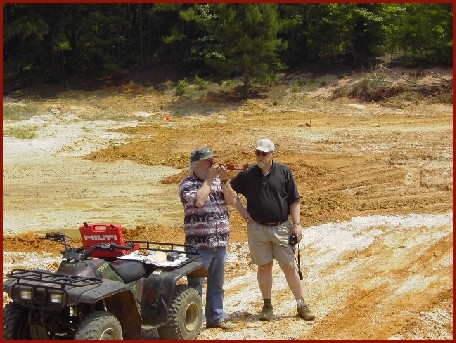
Dad is showing Stan how dad & I marked where the shoreline would be if the pond ends up holding one surface acre of water. It's possible for the pond to hold more than that. And, of course, it's possible for it to hold much less.

View from the north end of the pond. The dam is on the right.
- Harmon is nervous that the southern feeder channel can't hold water, so he built a small
dam in front of it. If the water makes it to the top of that dam, the lake will be one
roughly one acre. If the water makes it over that dam and the feeder channel holds water,
then the pond could become two or more acres.
- So now we wait - for rain. Harmon worked on and off for two weeks and thinks he sealed
our pond pretty well. But we won't know for sure until we have some good rain, which probably won't
occur until this October or November (2005) or maybe not until next Spring (2006). But you can bet
that I'll let you know as soon as I find out :)

Update #4 - February 5, 2006
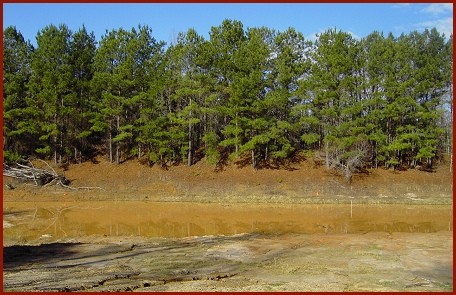

Update #5 - January 18, 2007

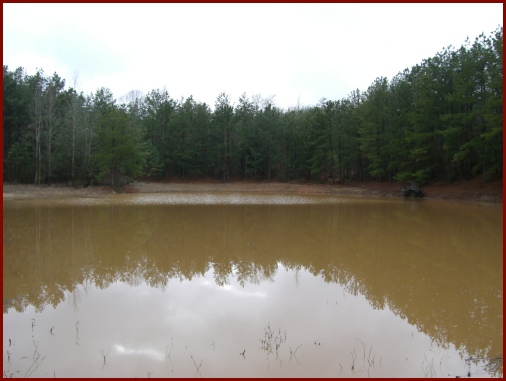

Note: through various measurments we now know that if the water ever gets to the top of the rail on the wooden bridge, the deepest part of the lake would be 15' 2" deep.

Update #6 - April 29, 2007

Since the January rains, the lake has been leaking at a rate of 3 to 4 vertical inches each week! As of this writing, the pond has dropped to 5' 1" at it's deepest part. Rain temporarily puts some water back into the lake, but then it seeps out at 3 to 4 inches per week. So it appears that the sealing did NOT work. Before Harmon did his work with the bentonite, the pond would lose one vertical foot per week due to seepage, so things have improved but it's still leaking way too much. We may talk to Harmon about this and see if it's worth paying him to spread more Sodium Bentonite clay onto the water surface, with the hope that the bentonite will sink to the bottom and be drawn into the leaky areas.

Update #7 - June 6, 2007

More Sodium Bentonite!
Update: Nope, the additional 24 tons of Sodium Bentonite clay (for a total of nearly 100 tons now) did not work. The pond actually leaks worse than before we tried to seal it with the Sodium Bentonite two years ago. We think that all the dozers and tractors broke what little natural seal the pond had. Very disappointing!!!

Background On Brushyland's Pond
Seven years later, in 1985, we thought that the pond site might actually be able to hold water but that perhaps there wasn't enough rain run-off going into the pond. So we had a 5-ft long electric water pump sunk several hundred feet and ran PVC pipe to the pond site. After several weeks of pumping water into the pond, there was a noticeable improvement. Soon, the pond was nearly full. It was beautiful - here is a page with some pictures and a video clip. We stocked it with fish and had a ball catching largemouth bass, catfish and brim. But after a year or so the pond began losing water. Soon it was back to it's puny size. Most of the fish died - their skeletons littered the growing shoreline. It was heartbreaking. Dad met with a guy from the Soil Conservation Department who said that there is a ring of leaky sand at the pond site. So fixing it seemed insurmountable.
But twenty years later, in 2005, I found a guy named Harmon Mansell via an internet Google search who seals ponds using a type of clay called Sodium Bentonite. Sodium Bentonite expands 10 to 15 times it's size when wet, so it is ideal for sealing ponds. And since it is a natural product it is not harmful to fish or humans. In June 2005, Harmon spent several days (over a two week period) trying to seal Brushyland's pond by working 72 tons of Sodium Bentonite clay into the pond's bottom. In most areas of the pond he laid down several inches of locally found clay and then a layer of Sodium Bentonite and then another layer of locally found clay. Unfortunately, two years after this work the pond was still leaking about a foot per month (it had been leaking a foot per week), so we hired Harmon to come back out in June 2007 to throw 24 more tons of Sodium Bentonite clay onto the water's surface in the hope that it will sink to the bottom and seal up the remaining leaks. Click here to see more about this effort.

Return to my home page